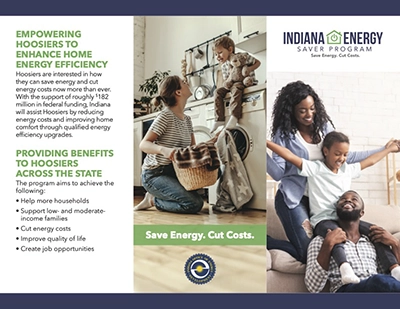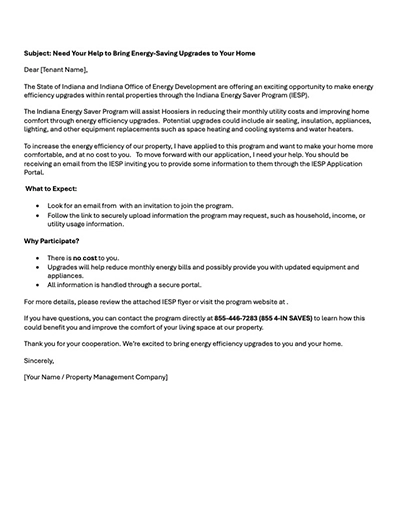Landlord Application Guidance
To apply for rebates through the Indiana Energy Saver Program (IESP), applicants must provide specific documentation to establish eligibility. For landlords and multifamily property owners the application process requires providing tenant contact information as tenant information is needed to determine property eligibility. Preparing or having these documents in advance can facilitate and expedite the application process.
Once you are ready, you can start your application. There are instructions available if you need additional assistance with the submission process: How to Submit a Full Homeowner or Landlord Application to the Indiana Energy Saver Program
Proof of Ownership
Properties must be located in Indiana. Applicants must be able to submit proof of ownership for the property. If there are multiple property owners, the applicant will need to attest that they can apply for rebates on behalf of the other owners.
Proof of Ownership includes property tax records, property insurance documents, or deeds.
Property or Building Eligibility
The IESP determines eligibility and provides energy efficiency measures for properties based upon the income levels of the tenant(s) that reside within a building. For multifamily properties, the entire property or building is eligible to receive the benefits of this program once 50% of the occupied units in that property or building are determined to be at or below the 150% Area Median Income (AMI).
Unit and Tenant Information
To determine eligibility, Landlord applicants will need to provide basic information about the unit(s) in the property and tenant contact information.
- Unit Information: Number of unit(s), unit number(s), and whether the unit(s) are occupied or vacant.
- Tenant Contact Information: Tenant Name, email address, and phone number.
The tenant contact information may be used to contact the tenant(s) to provide income documentation or to obtain natural gas or electric utility bill and usage information if they are the utility account holder.
Based on the size of the property, the IESP may be able to provide assistance during the application process to provide unit and tenant related information.
Proof of Income
The IESP determines program eligibility and issues rebates based on income. There are two options for verifying the income of a property: categorical eligibility or income documentation. Both require levels of coordination with tenant(s). Categorical eligibility is preferred as it utilizes documentation from other approved federal or state government issued to substantiate the income levels of the tenant(s) at the property or in the unit(s). Review the options below and select the one that best fits your situation.
Option A: Categorical Eligibility
Property owners or tenants participating in an approved federal or state program with an income qualification threshold equivalent to the relevant rebate threshold can submit an eligibility determination letter dated within the last 12 months to verify income eligibility. An award letter must display the following details:
- Recipient’s first and last name
- Recipient’s address
- Program name
- Date of enrollment and/or enrollment expiration date
Approved Programs for Categorical Eligibility:
- Housing Choice Vouchers (HCV)
- Head Start
- Housing Improvement Program (HIP)
- Housing Opportunities for Persons with AIDS (HOPWA)
- Lifeline Support for Affordable Communications (Lifeline)
- Low Income Energy Assistance Program (LIHEAP)
- Medicaid
- Supportive Housing for the Elderly (Section 202)
- Low Income Housing Tax Credits (LIHTC)
- National School Lunch Program
- Special Supplemental Nutrition Program for Women, Infants, and Children (WIC)
- Supplemental Nutrition Assistance Program (SNAP)
- Supplemental Security Income (SSI)
- Weatherization Assistance Program (WAP)
- Persons with Disabilities (Section 811)
Option B: Income Documentation
If an applicant does not participate in a program qualified for categorical eligibility, income documentation must be provided to verify eligibility. Income documentation is required for all adult household members receiving income in each of the unit(s) you are seeking to receive rebates for. If a household member has multiple sources of income (e.g., job income and Social Security), documentation for each source is required unless the household member provides their most recent tax return. The program will work directly with the tenant(s) to obtain this information by providing them with the ability to upload the documentation directly to the IESP.
The income documentation must display the following details:
- The company’s name and contact information
- The household member’s first and last name
- Date of pay
- Gross income amount (unless the income source is self-employment income)
Examples of income, acceptable documentation, and acceptable date ranges are provided in the table below:
| Income Type | Acceptable Documentation | Acceptable Date Range |
|---|---|---|
| Alimony |
|
|
| Annuity |
|
|
| Child Support |
|
|
| Job Income |
|
|
| Pension |
|
|
| Rental Income |
|
|
| Self-Employment Income |
|
|
| Social Security |
|
|
| Social Security Disability |
|
|
| Unemployment |
Need help finding these documents? Visit: https://www.in.gov/dwd/indiana-unemployment/ |
|
| Workers Compensation |
|
|
Utility Information
As part of the application process, the program asks if the property owner or tenant is the account holder for the natural gas or electric utility at the property. Based on the applicant’s response to this question, the IESP will then collect the utility data based on who account holder is for the utility; either the landlord or the tenant(s). Applicants should be prepared to provide 13 months of prior utility usage documentation as part of their application. For larger multifamily buildings, applicants may need to provide additional months of utility data.
Each document must include:
- Applicant’s first and last name
- Address
- Account number
- Utility provider
- Monthly Usage
- Date
- Meter Number (if applicable)
- Service Site ID (if applicable and for electric utilities only)
Applicants who receive delivered fuel such as propane must submit their most recent receipt. The receipt should include:
- Delivered fuel type
- Delivered fuel amount
- Address fuel was delivered
- Date fuel was delivered
The Indiana Energy Saver Program is working to partner with utilities to make it easier for you to share your utility consumption data directly with the program. Customers of participating utilities will only need to provide their most recent utility bill for each utility used in the home (listing the account number, meter number, or service site ID). More information on this process and participating utilities will be listed in the application.





